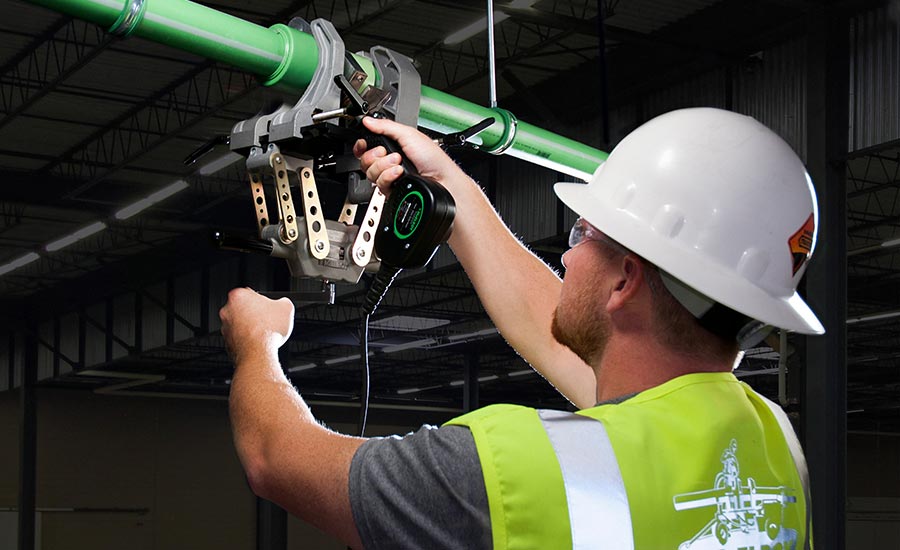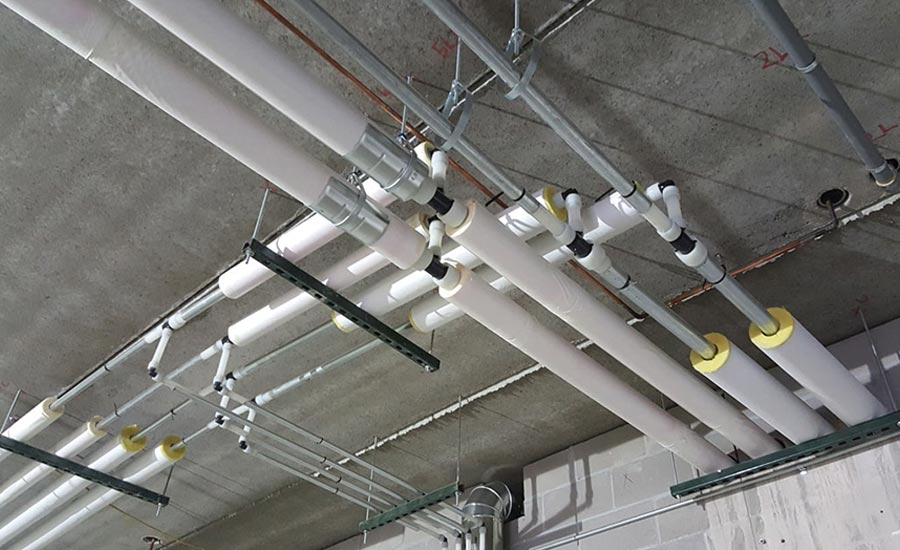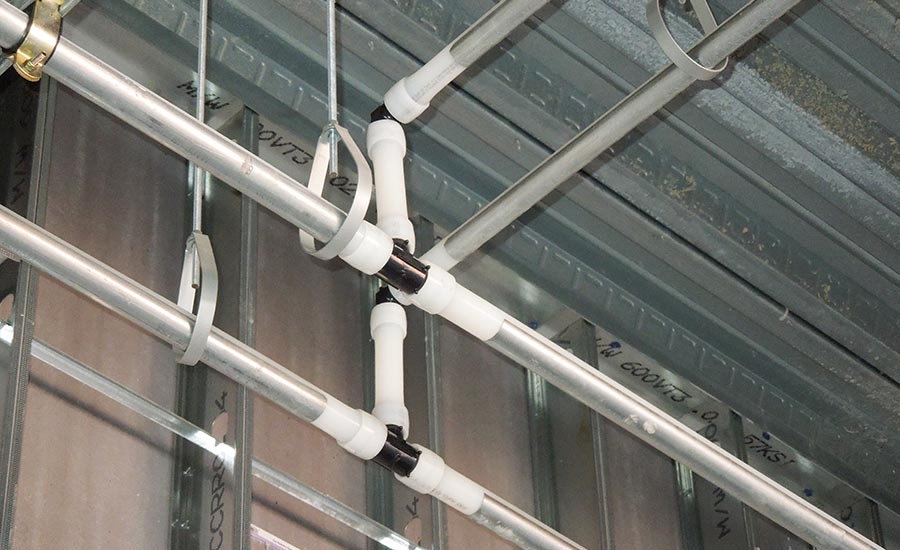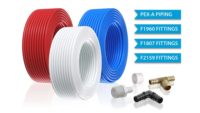The commercial building industry always has its eye on innovative solutions for higher-performing structures. In addition, with the global pandemic changing the way we design buildings, professionals are now thinking about safer design practices as well. And, of course, they always need to remain economically viable for the client.
Because engineers are responsible for meeting clients’ needs, as well as keeping a strong reputation for delivering high-quality designs, it’s important to understand the capabilities and limitations of these building solutions for greater confidence when specifying these products for commercial projects.
This tall order for safe, efficient and economically viable solutions is bringing several alternatives to the forefront of the commercial building sector. One solution that is standing out among the rest is polymer piping systems, such as PEX and PP-RCT.
Originally developed in 1968, crosslinked polyethylene (PEX) first hit the European market in the early 1970s and came to North America in the mid-1980s. Its durability, ease of installation and cost-effectiveness influenced the popularity of the product to the point where it became the most-installed plumbing piping for residential new construction, beating both copper and CPVC combined.
While the commercial world has been slower to adopt the technology, with some believing that metals are superior to polymers for rigorous commercial building design, increased demand for value-engineered projects has moved PEX to the forefront.
With a plumbing pipe offering in sizes up to 3 inches and hydronics piping in sizes up to 4 inches, PEX is challenging traditional copper and CPVC materials that have dominated commercial applications.
For PP-RCT, which is slightly newer to the market, these piping solutions can be available in sizes all the way up to 24 inches, so there are several options for domestic water as well as hydronic heating and cooling applications.
 While copper systems can corrode and experience scale build-up over time, PEX and PP-RCT are immune to these problems.
While copper systems can corrode and experience scale build-up over time, PEX and PP-RCT are immune to these problems. Safety of polymer piping systems
One of the best features of polymer piping systems is the durability. While copper systems can corrode and experience scale build-up over time, PEX and PP-RCT are immune to these problems, which can affect domestic water quality in the form of bad taste and odor, or even bacterial formation.
In addition, polymer joining methods do not require glues, cements or other chemicals that are necessary with CPVC systems. These joining chemicals have the potential to pose risk if they seep into the drinking water system.
Eliminating these issues that are unavoidable with other piping systems make PEX and PP-RCT a much healthier option for domestic-water systems, especially in hospitals or schools where clean water is vital.
PEX products listed to ANSI/NSF 61 Drinking Water System Components – Health Effects and evaluated by the ASTM F2023 test method for assessing oxidative resistance to hot, chlorinated water provide confirmation the pipe will not leach harmful substances into drinking water.
For PP-RCT, there are also various codes, standards, and listings, including:
- ASTM F2389 (Standard Specification for Pressure-rated Polypropylene Piping Systems);
- ASTM E84 (Standard Test Method for Surface Burning Characteristics of Building Materials);
- ASTM D2657 Standard Practice for Heat Fusion Joining of Polyolefin Pipe and Fittings;
- ANSI/NSF 14 (Plastic Piping Systems Components and Related Materials);
- ANSI/NSF 61 (Drinking Water System Components — Health Effects);
- CSA B137.11 (Polypropylene Pipe and Fittings for Pressure Applications); and
- ICC-LC1004 (PP, PEX, PEX-AL-PEX and PP-AL-PP Piping, Tube and Fittings used in Radiant Heating and Water Supply).
It is important to note that various PEX and PP-RCT manufacturers have their pipe tested and listed to many different codes, standards and listings. It is imperative to validate the pipe you are specifying has the proper regulatory requirements for the project.
 Polymer joining methods do not require glues, cements, or other chemicals that are necessary with CPVC systems. These joining chemicals have the potential to pose risk if they seep into the drinking water system.
Polymer joining methods do not require glues, cements, or other chemicals that are necessary with CPVC systems. These joining chemicals have the potential to pose risk if they seep into the drinking water system. Design efficiencies and considerations
When it comes to efficient design, polymer piping systems are the ideal solution. Take PEX, for example. With its flexible nature, pipe sizes under 1 inch are very easy to bend with each change in direction, eliminating the need for additional fittings that can restrict flow and affect performance. There are also rigid bend supports available that snap onto the pipe to keep those bends in place.
PEX pipe is manufactured to a standard dimension ratio (SDR) of 9, so the pipe offers ample temperature and pressure capabilities for various commercial applications.
PP-RCT is manufactured to several different SDRs, including 7.4, 9, 11 and 17.6. This provides many different design options when sizing for domestic water or hydronic heating and cooling applications.
Check the manufacturers’ specifications, but most PEX pipe temperature and pressure requirements are 200° F at 80 psi (pounds per square inch), 180° at 100 psi, and 73.4° at 160 psi. In accordance with ASTM F876, the minimum hydrostatic burst pressure for PEX is 480 psi (for 1/2 inch pipe) and 475 psi (for 3/4 inch pipe and larger) at 73.4°.
Per ASTM F2389, PP-RCT temperature and pressure requirements vary by SDR, so check with the manufacturer for each individual SDR temperature and pressure requirement.
The linear expansion rate of PEX is 1.1 inches/10° /100 feet. To accommodate this characteristic of the pipe, some manufacturers offer a galvanized steel channel that snaps onto the pipe to provide rigidity and increased hanger spacing similar to copper or other metal pipes.
For PP-RCT mechanical applications, some manufacturers offer a pipe that features a coextruded fiber composite middle layer that provides greater rigidity to significantly reduce expansion and contraction.
For thermal conductivity, both polymer piping systems offer advantages. PEX, in particular, has a very low coefficient of thermal conductivity of 0.219 Btu/(hr•ft²•°F). Copper, for example, has a coefficient of thermal conductivity between 300 and 400 Btu/(hr•ft²•°F), depending on wall thickness (Type K, L or M).
The thicker walls of PEX-a pipe act as an insulator, offering insulation values of approximately R-0.19. This characteristic gives PEX up to 30% better insulating value when comparing uninsulated PEX with uninsulated copper pipe.
 Various PEX and PP-RCT manufacturers have their pipe tested and listed to many different codes, standards, and listings. It is imperative to validate the pipe you are specifying has the proper regulatory requirements for the project.
Various PEX and PP-RCT manufacturers have their pipe tested and listed to many different codes, standards, and listings. It is imperative to validate the pipe you are specifying has the proper regulatory requirements for the project. Advantageous polymer piping applications
Both PEX and PP-RCT are approved for direct burial in the soil. This is especially advantageous for eliminating hangers in suspended piping applications, adding greater cost savings to the project.
For in-slab domestic water applications, pre-sleeved PEX is a highly innovative solution. These systems, which are embedded in the concrete slab, are safer and provide greater system efficiencies and performance. Because the system requires shorter pipe runs, it means less water volume, which requires less energy to heat and provides better hot-water delivery times.
It also means the water in the pipe spends less time in the optimal bacterial growth zone (95° to 115°), providing greater safety for the end user. Plus, the shorter runs provide better pressure to the fixtures for higher velocity to minimize biofilm attachment and growth, especially compared with metallic piping systems.
It is easy to see that polymer piping systems offer several advantages to commercial building designers, whether the primary focus is system performance, safety, efficiencies, or value engineering. To learn more about PEX and PP-RCT pipe and fitting systems, check out the Plastics Pipe Institute at plasticpipe.org or the Plastic Pipe and Fittings Association at ppfahome.org.



